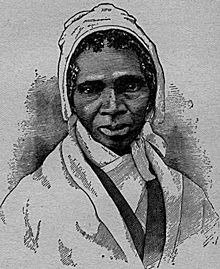| Revision as of 19:46, 22 May 2004 view source68.222.43.14 (talk)No edit summary← Previous edit | Revision as of 07:07, 1 June 2004 view source Kevyn (talk | contribs)Autopatrolled, Extended confirmed users8,395 editsm Corrected linkNext edit → | ||
| Line 8: | Line 8: | ||
| She escaped to ] in ]; after ] state abolished slavery that year, she returned there in ], worked as a domestic servant for over a decade, and joined ] in evangelical preaching on street-corners. | She escaped to ] in ]; after ] state abolished slavery that year, she returned there in ], worked as a domestic servant for over a decade, and joined ] in evangelical preaching on street-corners. | ||
| Later in life she became a noted speaker for both the ] movement and the ] movement. Perhaps one of her most famous speeches was ], a short but pointed commentary delivered in ] at the Women's Convention in Akron, ]. | Later in life she became a noted speaker for both the ] movement and the ] movement. Perhaps one of her most famous speeches was ], a short but pointed commentary delivered in ] at the Women's Convention in Akron, ]. | ||
| In 1850, she worked with Olive Gilbert to produce a biography, the ''Narrative of Sojourner Truth''. | In 1850, she worked with Olive Gilbert to produce a biography, the ''Narrative of Sojourner Truth''. | ||
Revision as of 07:07, 1 June 2004

Sojourner Truth (1797? - November_26, 1883) was the self-given name, from 1843, of an American abolitionist born into slavery. The name she was originally given was Isabella Bomefree (later changed to Baumfree). The year of her birth is uncertain, and is usually taken to be 1797.
She escaped to Canada in 1827; after New York state abolished slavery that year, she returned there in 1829, worked as a domestic servant for over a decade, and joined Elijah Pierson in evangelical preaching on street-corners.
Later in life she became a noted speaker for both the Abolitionist movement and the women's rights movement. Perhaps one of her most famous speeches was Ain't I a Woman?, a short but pointed commentary delivered in 1851 at the Women's Convention in Akron, Ohio.
In 1850, she worked with Olive Gilbert to produce a biography, the Narrative of Sojourner Truth. During the American Civil War, she organized collection of supplies for the Union.
See also: Slave narrative
In 1997 the NASA Mars Pathfinder mission's robotic rover was named "Sojourner" after Sojourner Truth.
External links and references
- Genealogy note
- Narrative of Sojourner Truth: http://digital.library.upenn.edu/women/truth/1850/1850.html
- An obituary written by Harriet Beecher Stowe is available from the Electronic Text Center, University of Virginia Library: http://etext.lib.virginia.edu/
- Biography at FemBio – Notable Women International
- Text of 'Ain't I A Woman?' Speech